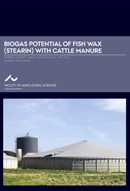DCA Publikationer
Biogas potential of fish wax (stearin) with cattle manure
Intern rapport Husdyrbrug, nr. 23, 2010
Af Alastair James Ward
 Biogas treatment of animal manure is common in Denmark, but still very little developed in Norway. Due to relatively small herds, large distances and low energy prices, costs are a challenge when constructing biogas plants on farm level in Norway. Residues from food industry may be an option to increase the biogas output. In Tingvoll, ca 120 km southwest of Trondheim, a pilot biogas plant for treatment of animal manure will be built on an organic research farm during 2010. Locally available food waste includes residues from fish oil production. Wax, soap and bleaching earth is available. Wax may also be utilized to replace fossil oil in heating boilers, and may hence be less relevant for biogas purpose. On the other side, bleaching soil and soap may contain elements that are not feasible for the biogas process, or for the biogas residue as a soil
Biogas treatment of animal manure is common in Denmark, but still very little developed in Norway. Due to relatively small herds, large distances and low energy prices, costs are a challenge when constructing biogas plants on farm level in Norway. Residues from food industry may be an option to increase the biogas output. In Tingvoll, ca 120 km southwest of Trondheim, a pilot biogas plant for treatment of animal manure will be built on an organic research farm during 2010. Locally available food waste includes residues from fish oil production. Wax, soap and bleaching earth is available. Wax may also be utilized to replace fossil oil in heating boilers, and may hence be less relevant for biogas purpose. On the other side, bleaching soil and soap may contain elements that are not feasible for the biogas process, or for the biogas residue as a soil
conditioner. Hence, wax was selected as the first residue to test for its biogas potential. Contact to the Research Centre Foulum at Århus University, Denmark, was established during a study tour in October 2009. Dr. Alastair Ward and his staff at Foulum conducted a trial with fish wax and cattle manure during December and January 2009-2010. The work was paid by the fish oil producer, GC Rieber Oils, Kristiansund, Norway. Bioforsk Organic Food and Farming, Tingvoll is scientifically responsible for the pilot biogas plant at Tingvoll, and has been the active partner in the contact to Research Centre Foulum from the Norwegian side. Århus University is grateful to GC Rieber Oils for the research task, and the permission to publish this report in the university report series.
